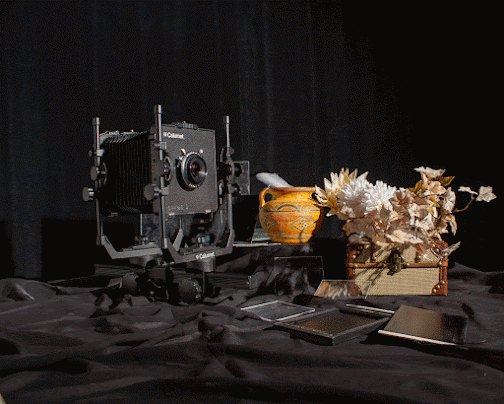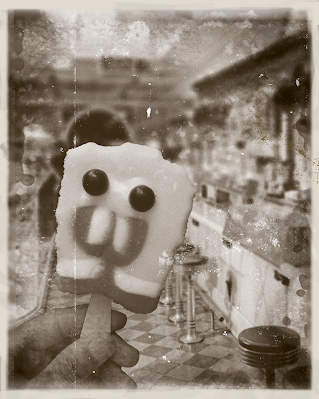Monday, January 29, 2024
Old is New Again - Fran Gatti
Old is New Again-Nikole McCahill
For this assignment I decided to use a more modern photograph. I chose an image of me in front of my jeep. I felt this created some sense of irony since the first “vehicle” was not invented until 1886 (aka the time of wet plate collodion photography). I thought it was also appropriate because I was using the jeep as a sort of prop for myself which most wet plate collodions used some sort of prop in portraits since the exposure time was so lengthy. I first made a clipping mask and removed the saturation and then added a vibrance filter to make it a more warm, yellow, aged photo. I used brushes and different blending modes over the entire photograph to make it “lower quality” as well as added a white glare and also some blacked out areas like it was introduced to light too fast. Additionally I added scratches and scuffs to distress the image. Around the edges I added a rough black around the edges as well as vignetting. Over the majority of the photo I added water/wet spots. Finally, I added a crack across my photograph from a LOC image so it looks like it was broken at some point in time.
Old is New Again - Hang Le
Old is New Again - Emily Furr

Old is the new again - Sanura Ezeagu
I centered my piece around witnessing major events in US history. I thought it would be fun and help my curiosity on how it would feel to be apart of something so big.
First I started with an image from the Library of congress. On there I found an image about the first plane in NC. I then added a picture of me and a cat (not mine) for a little comedy touch. I tried to math the tone of the photo and add textures to make the image interesting and time appropriate.b
Old is New Again- Madyson Young
I wanted to keep mine traditional yet a bit modernized at the same time. I was thinking of the candid photos I would often see along with people usually keeping a straight face in photos from that time. I wanted it to have a laid-back atmosphere while maintaining a sense of sophistication. With that, I distressed the image a lot with the custom brushes, as well as incorporating textures from my parents driveway which luckily, had cracks in it that gave a defined scratch look. Incorporating something from the library of congress was challenging only because I am indecisive and didn’t know which I should choose, but I finally chose the frame in my finalized version, which goes along with the colors. I originally didn’t have as much blemishes with the fear of adding too much, but I think in this case, the more blemishes the better it looked.
Sunday, January 28, 2024
Old is New Again ~ Kimberly Ballinger
Man's Best Friends
For my project I wanted to keep it simple as if it was just a moment of time where everything was calm and relaxed.
I started with the base image of my daughter's dog Selene standing and resting in between zoomies in their back yard. I then added my own cat Finley just because he is my buddy and is always cleaning in the funniest ways so I thought it would be a nice light-hearted addition.
I then used elements from four different photos from The Library of Congress, the main being the tent with President Lincoln and General McClellan. I liked having the seriousness of Lincoln and the General juxtaposed with two companion animals. It speaks to the basic idealization that dogs and cats have been by our sides for such a long time, even during difficult periods.
I decided to stick with black and white versus adding a sepia tone to align with the images I used for inspiration.
-Kim
Deconstructive Notion of Beauty
Old is New Again - Christi Montes
For this project, I chose to pick a topic related to the past and the present. This topic can pertain to many subjects outside of my point of view. I decided to reflect on the deconstructive notion of beauty, specifically to society and the past. While thinking of a more profound concept for this project, it would be perfect to relate it to my Latino culture.
Being Latina and Central American, we have traditional dances; within this dance, the girls usually braid their hair with a ribbon, and if they want to add flowers, they have beautifully made dresses for this special occasion.
"Brianne With an E" (Old is New Again) - Brianne Schriever
"Dream Against the Reality"- Jazmine Chance
Old is New Again: Dream Against the Reality
When first coming about this project, I was still determining what I wanted to do as a concept. But when I started shooting some pictures and doing some research, I realized I wanted my concept to explain more of the history of African American culture during the period when wet collodians were rarely popular (1850s).
During this time period, African American artists were faced with many challenges due to racism and discrimination. So when it came to men and women of this culture, anything out of the norm that gives the idea that African Americans have higher standards than what society portrays falls into an unjust category. The Fugitive Slave Law of 1850 made it dangerous for enslaved and free African Americans to pursue artistic careers as they could be captured and returned to slavery.
I created a narrative complex of the mindset of slavery where it is the dream versus the reality status that society pictures African Americans of this period. The images that I used from the Library of Congress Prints and Photographs Catalog are the border around the frame, the landscape, and the figures in the back to give the idea of being in that time period and what artists would dream to do versus what is actually true. She stares into the dreams of a traditional artist with print works in the most fashionable attire of the highest status an African American can have but still lives in a home where she is in bad living conditions.
Old is New Again Dominique Rodriguez
"I've Seen a Ghost" - Zoe Turner (Old is New Again)
Old is New Again - Julien Pozo
Personally, I just wanted to go for a simple and straight forward recreation of the effects often found on Wet Plate Collodion photographs. I don't think they're perfect and that's the point so I wasn't scared to add as much wear and tear as possible as the process is very volatile and tedious and reflects a very imperfect kind of result yet also crystal clear at times. As for what was collected and used from the Library of Congress, I had found a Civil War image that had some nice edges that were torn or damaged in the wet plate collodion process and there I wanted to use it since my overall composition for the original image was very centered and direct and so I thought the portion that I had incorporated from the LOC piece framed the very center focused composition I had within my portrait that I took and therefore complemented it very well in some ways. Overall a fun process!
Pearl of the Orient- Jonah Sanderson
For this project, I chose to composite an image that regarded the Western world's history of stereotyping different cultures and groups of people. In this image, I referenced the period's studio sittings with random objects such as Southeast Asian tropical plants, a Chinese lion statue, and a poster for herbal medicine. The purpose of this composition is to call to the practice of stereotyping in history as I represent my Filipino culture in my attire, the barong tagalog, but am surrounded by objects that do not quite fit my own heritage. The expression is meant to convey a sense of amusement as the subject understands the ignorance of the random props. We see examples of this in wet plates when we look to the work of Edward S. Curtis in his book, The North American Indian, where native people are presented in stereotypical and often arbitrary costumes for their own culture. I lifted the cracked plate in the top left from the Library of Congress and used stock images for the Fu Dog and Chinese calligraphy poster.
Old is New Again (Troy Vong Nguyen)
For my image, I wanted to explore landscapes and states of distress based on the environmental effects that golf courses leave on natural habitats. I took a photo of a golf course that was in my neighborhood and added in images from the Library of Congress that included large distressed states of the wet plates and composited them into the image as a way of conveying the harmful effects and damage to the natural environment from golf courses.
Picture Day (Savannah DeMao)
Saturday, January 27, 2024
Wandering to Valinor (by Suzanne Voigt)
During the 3rd age of Middle Earth, in J.R.R. In Tolkien's Lord of the Rings, Frodo and Sam come across a camp of Wood Elves who are leaving Middle Earth on their way home to Valinor. Having never seen elves before, Frodo and Sam are mesmerized by them and capture this scene of the elves and their camp within the forest near Woodhall. This of course is ironic since there were no cameras during the 3rd age of Middle Earth. For this fictional, digital wet collodion image, one wood elf is casually posing around the campfire while three others are going about their daily routines within the camp. The concept of my image stems from my current work around “wanderings” and how one can mature in their personal self-discovery by engaging in wanderings of many kinds. For many people, wandering can seem like a daunting or frightening prospect, however, with positivity and a strategic structure in place, wise wanderings go from concepts of treacherousness to an extraordinary mosaic of adventures.
To make this image look very old and worn, I decided to use aspects of a variety of images from the Library of Congress including a campfire scene by Highsmith, President Lincoln’s box at Ford Theatre, 17th NY Battery, and an Unknown Union Volunteer in the Civil War. To capture the subject matter for my image, I photographed myself in a variety of elvish capes and poses in the woods around my home using my Sony a7IV camera and 24-70mm lens. I also incorporated a few images from previously attended Renaissance festivals, which included the two tents and horse. For my apertures, I used a range of f/2.5 – f/5.6 to get a wide variety of focal depths. Finally, I incorporated some textured brushes to increase the blotches, blur, scratches, etc. around the figures and edging of the image. In all, this image is made up of 26 individual Photoshop layers.
Friday, January 26, 2024
Adrienne Ray- Old is New Again
I wanted to make something that related to the nineteenth century and my childhood. The parlor background came from the Library of Congress. It relates because ice cream parlors gained popularity in this century with the development of industrial refrigeration. I chose the subject based on my love of ice cream and other sugary foods. Even though cartoons hadn't been invented yet, I thought it would be humorous to photograph this SpongeBob popsicle. I used textures from creative cloud, blur effects, noise and my own watercolor texture to edit.


































